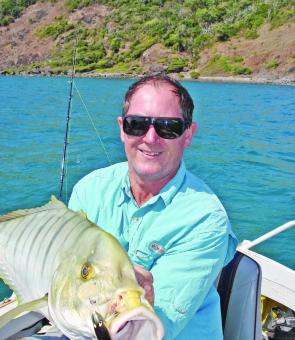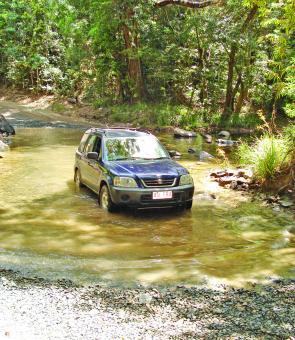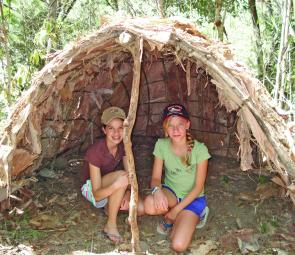Cooktown is one of those locations that many fishers pass by on their never-ending quest to get to the tip of Cape York. Having recently spent two weeks camping and fishing in the area, it is a destination well worth including on the itinerary.
You can travel to Cooktown via the all bitumen western route or have a more adventurous easy four-wheel drive journey through the Daintree, Cape Tribulation and Bloomfield. I chose to go up via the western route with a fully laden vehicle and boat in tow, with two mates, Rob Cannon and Paul Ulcoq. Our original objective was Weipa but logistics and the reality of two days driving each way compared to 4-5 hours, saw us settling on Cooktown and it proved to be the perfect choice.
It was a two phase holiday, with a nine day ‘boy’s trip’ followed by a four day family visit. That allowed time for the boys to do some serious exploring, which was right up our alley. We quickly broke our days down into a morning exploration by four-wheel drive and foot, and an afternoon fish in the boat. We then topped off the visit with a day on the reef aboard local reef fishing charter Hurricane.
Rob purchased two topographical maps of the area. These maps proved invaluable in our explorations and we had a ball heading off the beaten track in search of isolated fishing spots. The Cooktown area is littered with them and all it requires is a spirit of adventure, a good pair of walking shoes, a map, a GPS or compass, a bit of leg work and a four wheel drive, or even a Clayton’s four wheeler like my Honda CRV.
We found our way to places like King’s Plains Lake, the Little Annan Gorge, Archer Point, Trevethan Falls, waterholes on the East Normanby River and even fished remote sections of the McIvor River. A daypack is a definite necessity to carry water, a first aid kit and lures while keeping hands free to flick the snags and rock bars. It’s just a matter of getting out the map and looking for interesting features and heading off in search of them. We only came up empty handed once, when we tried to get to the McIvor River from the southern side via a disused track. We eventually came to the limits of my CRV’s off-road capability and had to turn back. We made it to the river a few days later by coming in from the northern side.
Cooktown’s infrastructure caters well for tourists and there are plenty of places to pick up maps and information, with all accommodation places having a ready supply. One map we found invaluable was a mud map of the Annan and Endeavour rivers, which we purchased from The Lure Shop in the main street, for the princely sum of $1. It is the best buck we spent, as it most importantly had marked on it all the rock bars in the rivers, and the Annan sure has more than its fair share.
We struck the full gambit of weather conditions during the two weeks, from flat calm to fresh to frightening, and the great thing about Cooktown is there is plenty to do in all winds. When the sea was flat we poked out the mouth of the Annan and had a ball flicking and trolling the endless headlands to the south. When it blew we chased barra, jacks and fingermark up the Annan and Endeavour rivers. About the only thing we came up empty handed on was crabs. We had three shots at them and never got a keeper, but September is not a good month for crabs in north Queensland so it wasn’t that surprising.
One thing we did note was the effect of tidal run on the river fishing. The tides were very neap during the first three days of the trip and the fishing was dead in the rivers. It was much better out the front but still not mind blowing. Once there was a bit of tidal movement the fishing came alive and we had a ball – especially on fingermark in the Endeavour. We flicked, trolled and live baited, and not surprisingly live baiting won hand’s down. Live sardines on a dropper rig placed near large fully submerged snags proved deadly.
It pays to spend the first day trolling around and marking good structure either in the memory bank or the GPS. That way you have plenty of spots to investigate further; either by luring or live baiting. We did this when the tides were neap, which allowed us to move to the fish when they weren’t moving.
Once the run returned on the lead up to the full moon we changed to luring and live baiting the snags and rock bars with considerable success. Barra were very quiet during our stay, though the jacks, and especially the fingermark, kept us entertained.
One place well worth a visit is Archer Point. About 20 minutes drive back along the western road, then in along a well graded dirt road.
This unique location is a very popular wild camping area with campsites tucked away in lots of little bays between headlands. It is very exposed to the elements however; so you need to be set up to cope with heavy winds if it blows. There are numerous land based fishing platforms in close proximity so a boat isn’t necessary, though very handy to open up a plethora of fishing options on the reefs and islands close to shore.
The view from the lighthouse hill is worth the journey alone. I took the kids there during a strong wind warning and they had a ball standing on the old concrete lighthouse platforms leaning into the wind to stay on their feet. They would jump in the air and the wind would blow them back half a metre before their feet hit the concrete again.
There is a small reef on the southern end that creates a sort of lagoon so a tinnie can be left anchored in moderate winds. We saw 12ft tinnies at anchor in moderate winds, and guys fishing from boats in the same conditions, so while it is exposed it’s still fishable in winds up to 20-knots.
There are numerous scenic walks around the historic township of Cooktown and there are pamphlets available in town showing the various tracks. A bit of pre-reading of a booklet called Tropical Walking Tracks Port Douglas, The Daintree and Cooktown is well worth the asking price of $8. It’s the perfect size to carry in your daypack once in town and the pre-reading gets you all fired up and lets you plan your itinerary in advance.
Cooktown is a very significant town in the exploration and development of north Queensland, especially the goldfields around the Palmer River. It has boasted populations around 30,000 in its boom times and consequently has a very rich history.
Historical sites that capture this era include the Cemetery, The Gunpowder Magazine, James Cook Statue, the Old Bank Building, the James Cook Historical Museum and numerous others. The aforementioned booklet sets out an excellent walk around the main historical sites, and as they are all in close proximity it is by far the best way to see them.
The great thing about Cooktown is the diversity of attractions, which has something for just about anyone, compressed into a relatively small area. If you can’t find something of interest in Cooktown then you are definitely a die-hard Metro junkie.
FACT SHEET
THE DRIVE
The drive to Cooktown is about 350kms by the inland route and about 100kms shorter by the coastal road. They both take between four and five hours, depending on stops.
The coastal road is passable by four wheel drive in all but the wet season, while the inland route is all bitumen and open year-round, except during flooding. The best inland route is to go north from Cairns along the coast and turn west just past Port Douglas.
ACCOMODATION:
Accommodation ranges from four star motel (Sovereign Resort Hotel – Ph (07) 40695400) to wild camping. We stayed at the Peninsula Caravan Park (Ph 07 40695 107), which has the cleanest amenities I have ever found in a campground.
If you prefer a little more isolation than the luxury bush camping, there is Endeavour River Escape, about 15 minutes out of town towards Hope Vale. They offer secluded individual campsites with their own campfire and a boat ramp on site. You can safely leave your boat in the water for the duration of your stay, which is a big bonus. There is plenty of other accommodation available, which can be viewed at http://www.cooktownbookings.com.au or simply by googling Cooktown accommodation.
FISHING
The best time, comfort wise, to visit is in the dry season from May to October but the fishing is better just after the wet and in the build up to the wet. September/October is a good compromise, as the fishing is hotting up but the heat is not yet unbearable.
The full gambit, from freshwater to blue water marlin fishing is on tap around Cooktown. If you are wanting to charter then it’s best to book well in advance. We went out on Hurricane (07 40695519) and were very lucky to strike one day in a period of weeks where there was a vacancy.
Cooktown 07 067
Paul with a small barra he caught while walking the banks of the upper McIvor River
Reads: 18921
Rob with the fish of the trip – a magnificent golden, trolled up south of the mouth of the Annan.

The Little Annan Gorge was worth the walk just to enjoy the scenery.

There are plenty of shallow river crossings on the coast road to Cooktown.

We stopped at the Bloomfield Falls and went on a conducted tour with aborigines from the nearby Wujal Wujal community.

Trevethan Falls was a magnificent place to have lunch and a swim.

The wind was so strong on top of Archer Point that the girls had to lean into it to stay standing.




